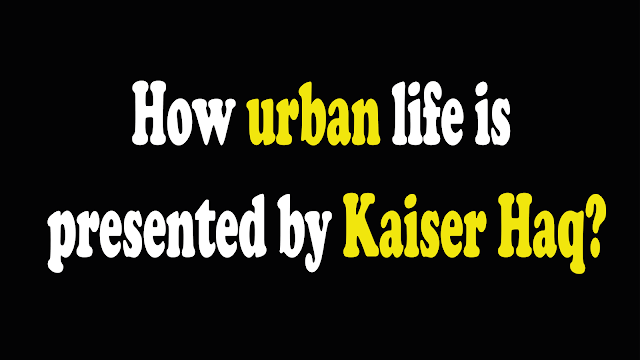From your reading of his poems, discuss how urban life is presented by Kaiser Haq?
Kaiser Haq’s Pariah & Other Poems dealt with every day, social and political problems of Dhaka city. Moreover, the poet’s own words convinced further about day-to-day life. Haq’s poetry was ironic and at the same time erudite which reached across the beauty and devastation of memory with progress and aging, death and loss, and the deterioration of people, community. In Pariah & Other Poems, there was evidence of activism that cast under the glaze of reminiscence: ‘I remember, I remember so well / My first protest march on a broiling summer day’. In ‘Kabbadi with Death’, written after the murder of Dhaka tailor Biswajit Das by Chhatra League activists. Just as poetry’s ‘helpless lines’ are acknowledged in ‘Kabbadi’, in ‘Getting it Right’, words were ultimately deemed inadequate weapons.
Haq spent a lot of time in the west for the sake of his education and when he was asked in an interview whether he was ever tempted to become part of that diaspora then he answered that he did think about this but never in a serious way. The poet also added that if he didn’t come to teaching then he would have certainly chosen journalism as his profession. The poet had beautifully articulated the present urban situation of the Capital in “Forever Amber.” Dhaka had been declared as the worst living city for several years in a row. The poet told that it was not an easy job for Dhaka city to be a Mughal Capital for two centuries. Dhaka streets were compared with “Parisian boulevards and arcades” where “alleys” and “bazaars” make up the capital’s portrait. But unfortunately, even the canals were filled to make more buildings, and this eventually turned into congested streets. The rivers were also polluted with poisonous chemicals. Dhaka had the finest fabrics until Manchester textiles destroyed our most popular muslin industry. There were very few muslin survivors who weave jamdani or Dhakai saris. The saris were highly expensive, but the weavers were poorly paid which was even lower than a garment’s worker.
“Rana Plaza is a symbol of the inhuman side of global capitalism”. This clearly stated how ill-structured it was. David Harvey in “The Redistribution of Real Income in an Urban System” mentioned addressing the urban system and the urban policies. And this essay could be connected with this. But unfortunately, here in Dhaka city no one was concerned about urban policies or equality. Everything here in the capital was corrupted. People were busy making money. There was a huge difference between the rich and the poor. There was no safety, especially for female workers. Female garments workers avoid walking in solitary rather they walk in groups even if their garments were within walking distance from their slums because of safety issues. But the positive side is that more females were coming forward to work in garments and no such crowd of women was seen earlier in Dhaka city, it is, therefore, a sociological revolution. It could be well connected with Jason Finch’s “Modern Urban Theory and the study of Literature” where he said that in the 20th century the city had become more theorized and professionalized like never before. The city’s population had drastically increased as people from rural areas come to Dhaka city as there were more job opportunities.
No matter which party came into the government, it was evident in the streets. They used very luxury cars like Mercedes, BMW, Lexus but demolish public got to pedal only three-wheelers or van. The powerful people got to drive their cars in the wrong directions while pedestrians cross the roads talking or chatting over the phone and cause dangerous accidents by taking away their lives. Traffic police controlled the chaos in a very ambiguous manner. Moreover, pavements were hogged by the local vendors, shops, and even beggars. Tiny houses were replaced with “stuffy jerry-built quarters.” There was a time when people used to come from work and go to the cinema or hang out with friends to refresh themselves. But now in the generation of Viber, Skype no one bothers to talk in person rather they were always busy with their smartphones. This could be related to the article “Writing the City” by Peter Preston and Paul Simpson-Housley where the authors mentioned the human experience and robotic lifestyle of the city. And we completely agree with the fact that the lifestyle of the metro had indeed become mechanical. Finally in “Forever Amber” the poet reminiscent of his early times where the colloquial phonetics like Chai garam(tea), Cheena badam(peanuts), Haat pattiss(hot patties) kept bustling in his ears. Even though things had changed but the poet was very nostalgic about the old Dhaka city.
The poem “Inheritance” described Pan Pacific Hotel in Dhaka city which was named after an old city called Sonargaon. The hotel was refurbished and chunks of bricks made the poet realize how things had changed in the present situation. The poet spent quite a lot of time there ignoring the beggars but now the same street had been developed with large buildings and a grocery market. The poet then pretended to watch the fountain which was here compared with chemical works. As the poet was waiting in the traffic to turn the light green, he then realized that the traffic police moved his arm as if he was some kind of referee who was pointing a goal. Through this, we can understand how busy life has become and everyone is in a competition of who would come first. This could also be seen from the perspective where city life had become professionalized which was said by Jason Finch in a chapter “Modern Urban Theory and the study of Literature.” The intricacy of the city can be found where the poet mentioned that in the midnight huge trucks came to the market with three times their capacity. David Harvey also described that the city was a complicated thing in the book Social Justice and The City. We agreed with the fact that the city had indeed turned into a complex thing where the corruption rate was at its peak and this could be understood from the line “Trucks laden with produce to three times their capacity”. Interestingly people made this corruption at night when no legal actions could be taken against them but the same person would not dare to make such corruption at daytime. “It’s something I’ll never forget the smell of barbeque” gave the most horrendous imagery where one could literarily feel the pain and disturbance in “Barbeque.” The poem began with the poet’s remembrance of a protest which he attended when he was only twelve. The protest was against a new education policy. On that day the Headmaster declared early school out and every student went home happily except two. The poet and his friend joined the march. There was a continuous murmur of slogans and very soon the poet and his friend started to prompt the slogan master but then the constant shooting of tear gas and bombs started which turned into a war. People were badly wounded but the poet did what he had to do as a concerned citizen. In this part, we can connect this with the essay by Donald B. Gibson’s “The Harlem Renaissance: Its Multi-Illusionary Dimension.” This is where Donald B. Gibson talks about the risks in city life and eventually, this was up to us how we conceive the city. We did agree that the city had its own risk but at the same, we also needed to take the initiative of a concerned citizen to come forward and fight for the right. And this was exactly what the poet had done, even though he knew there were risks of dying but he still joined the protest and fought for his right.
“Buriganga Blues” was one of the poems that was refreshingly bold. It was crafted in such a way that grabed the reader immediately and hold them till the end. The poem started with the poet brushing his teeth in downtown Dhaka also in parallel to shaving with his three-month-old razor. Then he caught a newsboy’s hand waving at him, but the poet was in dilemma whether he should wave back or not and even if he waved back would be waving towards a “renewed allegations of corruptions or allegations thrashed.” The poet mourned the eternal problems of the small town and the countryside. Women were sent to Coventry and were tortured for so-called adultery. But there was no news about this because no one cared. Everything was so corrupted that no one bothered if anything was going wrong. That was why the poet said “let them drag me to the black water” because everyone knew the Buriganga river was full of toxic pollutants, but people still go there, no one bothered to clean it or take any initiative regarding this. Our society had become exactly like the Buriganga river, everyone knew it was getting corrupted day by day but no one came forward to change it. In “The Problem of London” the book Conceiving the City: London Literature and Art by Nicholas Freeman said that Paris was the true capital but unfortunately Dhaka couldn’t be that true capital since it was way too corrupted for the city dwellers.
In “Eid Mubarak” we looked at Eid through a sixty-plus man who did not look forward to Eid like before. Now that even the air had become toxic, there was nothing pure left in the city. It was only considered a “teetotallers’ carnival.” But the poet gave a brief description of his childhood Eid days where he would break his fast in summertime Ramadan with lemonade. He would also give a lustrous smile when the moon appears and then there was a fresh smell of heena paste which would be happily applied. The kitchen would bustle with various kinds of dishes. Early morning shower and new clothes and the fragrance of attar could never be replaced. Collective prayer of the Eid following the criss-cross hug to the count of three was what would make a perfect beginning of the Eid day. But now Eid was not like that before, and this was what the poet missed here. The capital had become so corrupted that the poet did not now look up to the Eid days, but the memories of Eid remained with the poet forever. And this was exactly what was said in “Writing The City” by Peter Preston and Paul Simpson-Housley from the book Writing the City where Saul is calling the city “the expression of the human experience it embodied, and this included all personal history”. And we completely agreed here because in “Eid Mubarak” the poet was narrating his human experience which also embodies all personal history of his childhood during Eid days.
Poet’s childhood city and the present city were somewhat contrasting. Day by day the city was becoming more toxic, and this was why the poet had a strong desire to leave the capital and move to a calm place. Kaiser Haq being the urban poet illustrated urban consciousness to the fullest in his poems. On the contrary, the poet created a utopia where he wanted to go. This was because the poet could not find any similarities between the capital when he was young and now old, and which was why the poet wanted to go to a place where no one was oppressed by others.

